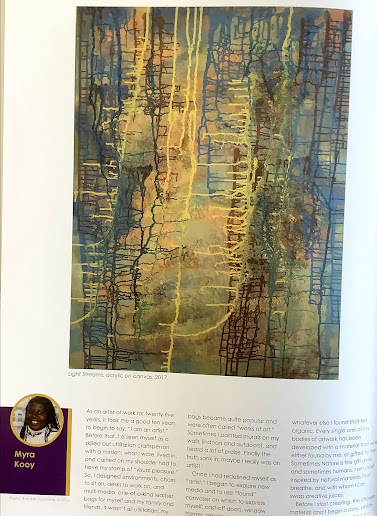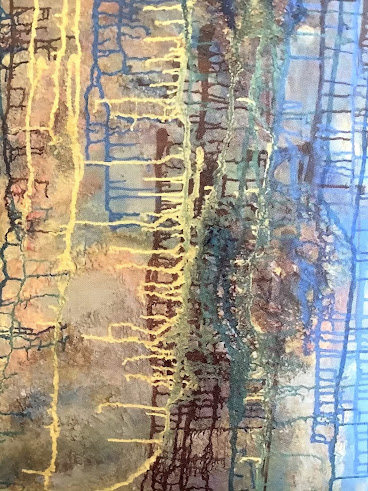"Sewing has a visual language. It has a voice. It has been used by people to communicate something of themselves--their history, beliefs, prayers and protests."~ from Threads of Life by Claire Hunter
Twenty-eight years ago I made my first quilt and it changed my life. As I honed my skills I was inspired by historic and traditional quilts but also by art quilts.
Early on I dreamed of being able to make quilts that represented my values, interests, and views. I eagerly learned new skills, from hand embroidery and hand quilting to surface design, machine thread work, and fusible applique. I have been making a series of quilts on authors I love. I have created a Pride and Prejudice storybook quilt, an Apollo 11 quilt, and embroidered quilts of the First Ladies, Green Heros, and women abolitionists and Civil Rights leaders.
 |
With my quilt I Will Life My Voice Like A Trumpet,
2013 AQS Grand Rapids quilt show |
I was excited to be given an egalley of Claire Hunter's book
Threads of Life: A History of the World Through the Eye of a Needle.
Hunter identifies themes in needlecraft including power, frailty, captivity, identity, connection, protest, loss, community, and voice. She shares a breathtaking number of stories that span history and from across the world.
Hunter begins with the history of the
Bayeux Tapestry, a panel of wool embroidery showing scenes from the Battle of Hastings in 1066. Its history illustrates the ups and downs in cultural attitudes toward needlework.
 |
| detail from Bayeux Tapestry |
It was forgotten, nearly upcycled, and used for a carnival float backdrop. Napoleon put it in a museum until it fell out of fashion and was again relegated to storage here and there. Himmler got a hold of it during WWII and publicized the artifact and saved it from destruction. Then the French Resistance took possession of the Louvre and the tapestry.
900 years later, the tapestry attracts thousands of viewers every year, a worldwide cultural icon, and inspired
The Games of Thrones Tapestry.
Yet, we don't know who designed the tapestry or embroidered it, the challenges and tragedies they faced. They remain anonymous.
I was familiar with the
Changi prison camp quilts created during WWII by women POWs in Japanese camps. Hunter explains how the women created images with personal and political meaning to tell loved ones they survived.
 |
| quilt made in the Changi Prison Camp |
I have seen Mola reverse applique but did not know it was an invention of necessity. Spanish colonists in Panama and Columbia insisted the indigenous women cover their chests. Traditionally, the women sported tattoos with spiritual symbols which they transferred to fabric. In many cultures, cloth has a spiritual element.
 |
| Mola Blouse, c. 1990, from the International Quilt Museum |
Hunter also touches on Harriet Power's Bible Quilt, Gees Bend quilters, the Glasgow School of Art Department of Needlework, and Suffragists banners.
There was much that was new to me. How Ukrainian embroidery was forbidden under Soviet rule as they systematically dismantled cultural traditions. Or how the Nazis used Jewish slave labor to sew German uniforms and luxury clothing.
Hunter tells stories from history and also how needle and thread are employed today as therapy and as community engagement and to voice political and feminist statements. She tells the memorable story of guiding male prisoners in the making of curtains for a common room and how she worked with groups, Austrian Aboriginies and Gaelic women, to make banners addressing displacement and community disruption.
We also read about the history of sewing, the impact of industrialization and the rise of factory production, the home sewing machine, the shift from skilled craft to homemade decorative arts.
Art quilters and textile artists like Faith Ringgold and Judy Chicago are discussed.
Social awareness needlework included the quite well known Aids Quilt but also the little known banner
The Ribbon, created to commemorate the 40th anniversary of the nuclear bombing of Hiroshima and Nagasaki. Justine Merritt organized the sewing of peace panels to be stitched together. 25,000 panels were made. 20,000 people collected on August 4, 1985, to wrap the 15-mile long Ribbon around the Pentagon, the Arlington Memorial Bridge, the Lincoln Memorial, and to the Capital and back to the Pentagon. The media and President Reagen ignored it.
Threads of Life may seem an unusual book, a niche book, but I do think it has a wide appeal that will interest many readers.
I was given access to a free egalley through NetGalley in exchange for a fair and unbiased review.
Threads of Life: A History of the World Through the Eye of a Needle
by Clare Hunter
ABRAMS
Pub Date 01 Oct 2019
ISBN
9781419739538
PRICE
$26.00 (USD)
from the publisher
A globe-spanning history of sewing, embroidery, and the people who have used a needle and thread to make their voices heard
In 1970s Argentina, mothers marched in headscarves embroidered with the names of their “disappeared” children. In Tudor, England, when Mary, Queen of Scots, was under house arrest, her needlework carried her messages to the outside world. From the political propaganda of the Bayeux Tapestry, World War I soldiers coping with PTSD, and the maps sewn by schoolgirls in the New World, to the AIDS quilt, Hmong story clothes, and pink pussyhats, women and men have used the language of sewing to make their voices heard, even in the most desperate of circumstances.
Threads of Life is a chronicle of identity, protest, memory, power, and politics told through the stories of needlework. Clare Hunter, master of the craft, threads her own narrative as she takes us over centuries and across continents—from medieval France to contemporary Mexico and the United States, and from a POW camp in Singapore to a family attic in Scotland—to celebrate the age-old, universal, and underexplored beauty and power of sewing. Threads of Life is an evocative and moving book about the need we have to tell our story.














































